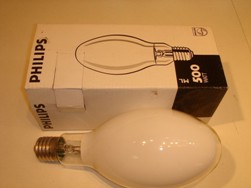Categories: Featured Articles » Sources of light
Number of views: 92350
Comments on the article: 12
DRV lamps: a popular hybrid of two different sources
The article talks about the popular hybrid mercury-tungsten lamps.
 Sometimes lighting engineering presents surprises: an unsuccessful light source gains so much popularity that leading lighting companies are engaged in its mass production. This is about lamps of arc mercury-tungsten (DRV).
Sometimes lighting engineering presents surprises: an unsuccessful light source gains so much popularity that leading lighting companies are engaged in its mass production. This is about lamps of arc mercury-tungsten (DRV).
Structurally, a mercury-tungsten lamp is a discharge mercury burner similar to DRL lamps. But in addition, a tungsten spiral is mounted in series with the burner in the bulb. It is located in an external flask, in an argon atmosphere, and serves as a current-limiting element for the burner. Such a lamp does not require external ballast equipment (PRA) and can be directly installed in the lamp instead incandescent lamps.
It was this opportunity that led to the commercial success of DRV lamps. The point here is not only the poverty of enterprises in the CIS countries - the demand for this type of lamp is very high in countries with developed economies. The reason is that a huge fleet of umbrella-type lamps inherited from powerful incandescent lamps. The replacement of such lamps, especially in industrial premises, is associated not only with the lighting devices themselves, but also with the fastening systems and wiring of the lighting lines.
Therefore, the possibility of directly replacing traditional lamps with more efficient hybrid sources ensured a very high demand for DRV lamps. In Ukraine, more than 60% of purchases of high-pressure mercury lamps are in mercury-tungsten light sources.
But you need to be aware that the light parameters of such sources are much worse than even not very effective DRL lamps. The reasons and features of the operation of DRV lamps will be discussed below.
At first glance, the efficiency of a hybrid source should be higher than that of each individual source: a mercury burner excites a phosphor, and a tungsten spiral additionally gives a small but its contribution to the total light flux. In practice, the opposite is true: the efficiency of DRV lamps is 30-50% percent lower than that of DRL lamps with an inductive choke.
We will try to understand the reasons for this phenomenon. First of all, about the efficiency of the glow of a tungsten spiral, which plays the role of a current limiter through the burner. Its resistance and power are calculated from the conditions of the starting conditions of the mercury burner. At the initial ignition, the voltage on the burner is equal to two cathodic potential drops, i.e. about 20V.
As the burner ignites, the voltage on it rises to 60-70V, and on the spiral it, accordingly, decreases. Therefore, in the operating mode, the tungsten spiral shines a little better than an incandescent lamp that is turned on at half the operating voltage. But the light is shining! The second reason for the low efficiency of the DRV lamp is less obvious.
The DRL lamp burner usually operates with inductive ballast. When the voltage of the network passes through the amplitude value, the inductance begins to transfer the stored energy to the load, "pulling" the voltage on the burner. Therefore, the “platform” for highlighting a plasma column when powered by inductive ballast is about 80% of the half-voltage of the mains voltage.
But when current is limited by active ballast (tungsten helix), such pumping of energy is absent. Therefore, the duration of the glow of the burner is reduced by 25-30%. Accordingly, the luminous flux and lamp efficiency fall. The contribution of the glow of the tungsten spiral cannot compensate for this drop; it can be neglected altogether.
Therefore, DRV lamps even from leading manufacturers (Philips, OSRAM) have an efficiency of not more than 30 lm / W. For comparison: DRL lamps of these companies have a return of 40-50 lm / W. Relatively low light output and a short service life, usually not more than 4000 hours, is a characteristic disadvantage of DRV lamps. It is defined by a tungsten spiral and makes these hybrid sources disadvantageous for outdoor lighting. Replacing such lamps requires the use of towers, which increases operating costs. But the use of DRV lamps for indoor workshop lighting will continue to stimulate demand for these lamps for a long time to come.
The nomenclature of these sources is limited: lamps with a power of 160 with a base E27 and more powerful lamps 250, 500W with a base E40. Some firms offer lamps with a capacity of 700 and 1000W, but they have even more limited use.
See also at e.imadeself.com
:
